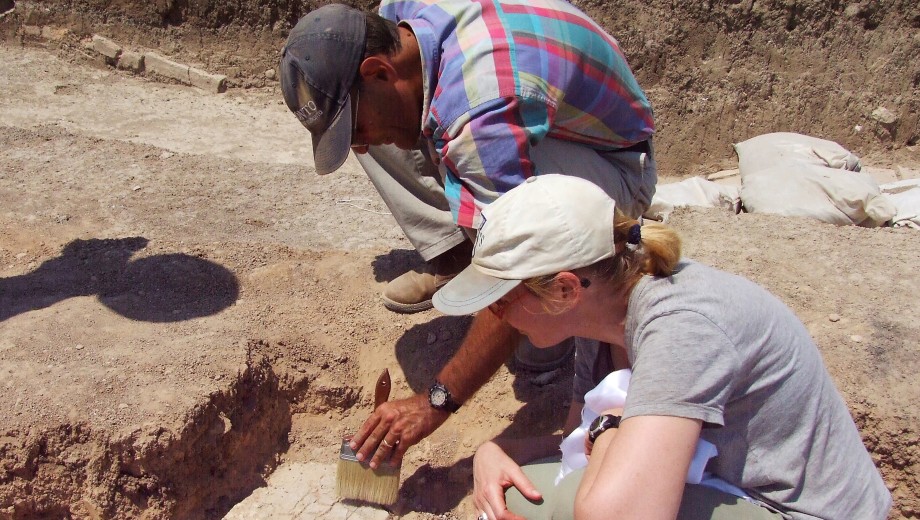“Doing fieldwork in the Middle East is not an easy thing,” says University of Toronto archaeologist Timothy Harrison, AM’91, PhD’95. “Everything’s contested.”
Since 2004, the OI-trained professor has directed the Tayinat Archaeological Project in the Amuq Valley in southeastern Turkey. That project began in 1999, but it can be viewed as a continuation of an earlier expedition that packed up its gear more than 60 years before.
From 1935 to 1938, an Oriental Institute expedition excavated the archaeological mound of Tell Tayinat, discovering a complex of buildings dating from the Iron Age (800–500 BCE), as well as indications of a much earlier Bronze Age settlement from the third millennium BCE. The team’s finds included a wealth of pottery sherds and other artifacts inscribed in the ancient Akkadian, Aramaic, and Luwian languages. They also found a structure that so closely resembles King Solomon’s temple as described in the Old Testament that biblical scholars have used it as a model for what that building, said to have been located in ancient Jerusalem, might have looked like.
Today, Harrison, who has more than 35 years of experience in the field, brings to Tell Tayinat a particular interest in how small, complex societies arose in the Eastern Mediterranean amid clashes between regional and local powers. The site seems to have hosted the capitals of a succession of Bronze and Iron Age polities that lived in tension with more powerful states. Then as now, this borderland, situated between Antakya (ancient Antioch), Turkey, and Aleppo, Syria, is a dynamic and disputed cultural crossroads.
A major twenty-first-century challenge to the region—including its cultural preservation—has been Syria’s now decade-long civil war. The looting and destruction of antiquities by ISIS, supposedly to combat idolatry, peaked in 2014–15 when the organization had captured large swaths of territory. But Harrison offers a subtler example of how cultural heritage is bound up with nation-building, identity, and politics.
In 2012 the University of Toronto team unearthed an unexpected pair of objects under a gateway leading to a royal citadel. First was a colossal stone sculpture of a human head and torso measuring 1.5 meters tall (likely 3.5 meters when it was intact). On the back was a Luwian inscription extolling the deeds of the bearded figure, one King Suppiluliuma—probably the neo-Hittite king known for waging war against Assyria’s King Shalmaneser III in the early ninth century BCE. The second object was a roughly one-meter-tall column on which the figure presumably rested, which bore carvings of a winged bull and sphinx.
Harrison says it is interesting how the figure became part of the local public discourse. Tayinat stands at the crossroads, he explains, of “the Turkish highland Anatolian cultures and the Syrian Semitic populations.” Because the Hittites are an ancient Anatolian culture, the discovery of a likeness of a neo-Hittite ruler at the site helps to locate it within the cultural history of Turkey rather than Syria.
Unsurprisingly, the find was hailed by Turkish media and officials, who visited the site and held news conferences with Harrison and his team. There are now licensed miniature replicas of King Suppiluliuma for sale. “We don’t make any money from it,” Harrison says, “but it’s entered into the public imagination.”
Although they have not become souvenirs, other findings from the Tayinat excavation have included a mysterious defaced sculpture of a woman whose thousands of fragments the team is now reconstructing, a sculpture of a seated lion that gives clues to local artistic traditions, and another temple resembling King Solomon’s. Within this temple was discovered a remarkably complete “succession treaty” from the seventh century BCE that imposed on the local population an oath of loyalty to the son of the Assyrian king—a tangible representation of the growing power of the neo-Assyrian Empire at the time.
Harrison’s excavations at Tell Tayinat “have proved transformational for our understanding of Iron Age social processes,” says James Osborne, assistant professor of Anatolian archaeology in Near Eastern Languages and Civilizations.
Harrison’s work goes well beyond this one site. He also heads up the Tell Madaba Archaeological Project in Madaba, Jordan, part of an international effort to analyze “the adaptive strategies and social institutions developed by human communities in the semi-arid highlands of central Jordan.” This focus on integrating data from disparate sources—including climate data—is also indicative of broader concerns in his work.
Since 2012 Harrison has directed the Computational Research on the Ancient Near East (CRANE) project, which addresses the idiosyncratic and specialized nature of much archaeological research: “Everybody has their own methods, their own recording systems,” Harrison says. “We are building more standardized methodologies.” Project members include UChicago professor in Near Eastern Languages and Civilizations David Schloen and Scott Branting, AM’96, an archaeologist at the University of Central Florida.
Some of Harrison’s most enthusiastic collaborators are not archaeologists but climatologists. If climate researchers have mathematical models running on supercomputers, archaeologists hold the rich historical data that can help validate those models. This information is valuable: if your theory matches up with what we know of the past—based on, say, chemical analysis of ancient plant material found at a particular site—it is that much more reliable for predicting the future.
Scientists often reach out to Harrison to collaborate, and he urges humanists to take a similar attitude to working across fields. “I think that we have intense relevance,” he says, noting that as department chair he often articulates this relevance for the “grand challenges” facing humanity—whether this means modeling climate change or examining cultural identity and conflict in the Middle East.
Fascinated by archaeology since childhood, Harrison says the University of Chicago was his “dream school.” Raised in what he describes as a conservative religious family—his parents were both missionaries in the Philippines, where he grew up, and he got his bachelor’s degree at Wheaton College, an evangelical Christian school in Illinois—he says the University was a “pure place of learning” that was “invigorating, challenging, and just incredibly stimulating to me coming from my background.”

